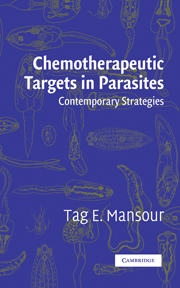Book contents
- Frontmatter
- Contents
- Preface
- Acknowledgments
- 1 The Search for Antiparasitic Agents
- 2 Biophysical, Genomic, and Proteomic Analysis of Drug Targets
- 3 Energy Metabolism in Parasitic Helminths: Targets for Antiparasitic Agents
- 4 Antimalarial Agents and Their Targets
- 5 Antitrypanosomal and Antileishmanial Targets
- 6 Targets in Amitochondrial Protists
- 7 Neuromuscular Structures and Microtubules as Targets
- 8 Targets in the Tegument of Flatworms
- Epilogue
- Index
- References
4 - Antimalarial Agents and Their Targets
Published online by Cambridge University Press: 11 August 2009
- Frontmatter
- Contents
- Preface
- Acknowledgments
- 1 The Search for Antiparasitic Agents
- 2 Biophysical, Genomic, and Proteomic Analysis of Drug Targets
- 3 Energy Metabolism in Parasitic Helminths: Targets for Antiparasitic Agents
- 4 Antimalarial Agents and Their Targets
- 5 Antitrypanosomal and Antileishmanial Targets
- 6 Targets in Amitochondrial Protists
- 7 Neuromuscular Structures and Microtubules as Targets
- 8 Targets in the Tegument of Flatworms
- Epilogue
- Index
- References
Summary
Before the basic principles of modern chemotherapy were established in the early part of the twentieth century large numbers of the known antiparasitic agents were adapted from ancient remedies. The rationale for using these agents was based on subjective observations of alleviating symptoms of the disease or, in the case of intestinal parasitic worms, evacuation of the parasites from patients. Once the biology of the parasites' life cycle was established and methods were devised to evaluate the effectiveness of the therapeutic agents, a more scientific approach was taken to assess the mechanism of action of these drugs using in vitro cultures or experimental animals.
Malaria remains the most challenging disease that afflicts humankind, both in prevalence and in the morbidity and mortality it causes. It is estimated that 300–500 million people in developing countries have acute infection. Of these, 1.5–2.7 million, mostly children, die every year. The disease is characterized by shaking chills, relapsing fever, mental or physical exhaustion, splenomegaly, and anemia. The disease is caused by four species of the genus Plasmodium (P. falciparum, P. vivax, P. malaria, and P. ovale). P. falciparum causes the most serious form of the disease. The vector for the parasite is a female mosquito of the genus Anopheles.
The infective stage of malaria, the sporozoite, is injected by the mosquito from its salivary gland while it is feeding on mammalian blood (Fig. 4.1).
- Type
- Chapter
- Information
- Chemotherapeutic Targets in ParasitesContemporary Strategies, pp. 58 - 89Publisher: Cambridge University PressPrint publication year: 2002
References
- 1
- Cited by



